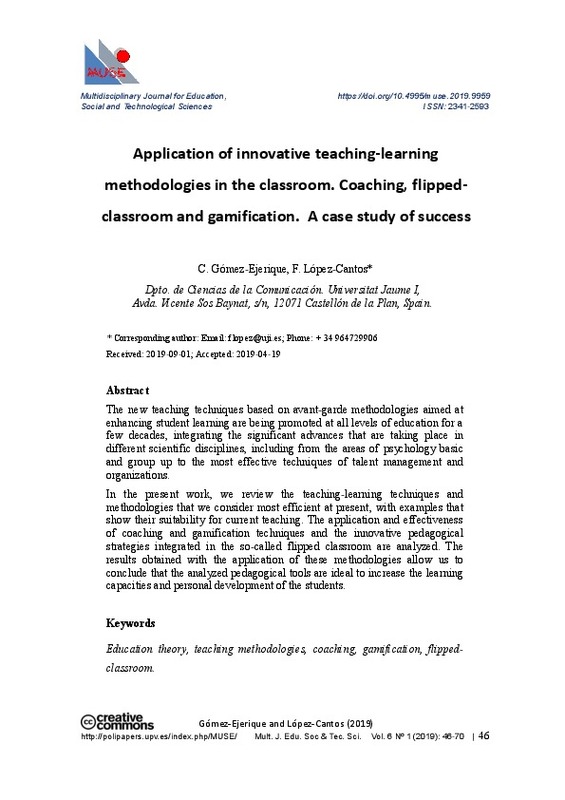Albrecht, C.S. (2012). The game of Happiness. Gamification of positive activity interventions. Maastricht University. Maastricht, The Netherlands.
Baker, J. W. (2000). "The classroom flip: Using web course management tools to become the guide by the side." Selected Papers from the 11th International Conference on College Teaching and Learning. 2000.
Bandura, A. (1997). Self-efficacy: The exercise of control. New York: W.H. Freeman.
[+]
Albrecht, C.S. (2012). The game of Happiness. Gamification of positive activity interventions. Maastricht University. Maastricht, The Netherlands.
Baker, J. W. (2000). "The classroom flip: Using web course management tools to become the guide by the side." Selected Papers from the 11th International Conference on College Teaching and Learning. 2000.
Bandura, A. (1997). Self-efficacy: The exercise of control. New York: W.H. Freeman.
BBVA Innovation Edge (2012). Gamificación, el negocio de la diversión, 3, 1- 65.
Bruns, B. and Luque, J.. (2014). Profesores Excelentes: Cómo mejorar el aprendizaje en América Latina y el Caribe. Washington, DC: World Bank.
Chi, M., Glaser, R. and Farr, M. (1988). The Nature of Expertise. Ed. L. Erlbaum Associates.
Chorney, Alan I. (2012). "Taking the game out of gamification", Dalhousie Journal of Interdisciplinary Management, 8, 1-14. https://doi.org/10.5931/djim.v8i1.242
Claxton, G. (2008). What's the point of school? Rediscovering the heart of education. Oxford: Oneworld.
Diaz, J. and Troyano, Y. (2013). "El pontencial de la gamificación aplicado al ámbito educativo", III Jornadas de Innovación Docente. Innovación Educativa: respuesta en tiempos de incertidumbre. University of Sevilla.
Esquivias Serrano, M. (2004). "Creatividad: definiciones, antecedentes y aportaciones", Revista Digital Universitaria, 1 (5).
Gros, B. (2007). Videojuegos y aprendizaje. Barcelona: Graó.
Hargreaves, D. (2004-2006). Personalising Learning. Pamphlet, Series. London: Specialist Schools Trust.
Harvard Business Essentials (2005). Coaching y Mentoring: cómo desarrollar el talento de alto nivel y conseguir mejores resultados. Barcelona: Editiones Deusto.
Kapp, K. (2012). The Gamification of Learning and Instruction: Game-Based Methods and Strategies for Training and Education. San Francisco: John Wiley & Sons. https://doi.org/10.1145/2207270.2211316
Neisser, U. (1976). Psicología Cognoscitiva. Editorial Trillas: México.
Padilla, S.; Halley, F. and Chantler, J.C. (2011). "Improving Product Browsing whilst Engaging Users", Digital Engagement, 11, 15-17.
Pérez Rodríguez, P. M. (2004). "Revisión de las teorías del aprendizaje más sobresalientes del siglo XX", Tiempo de Educar, 10 (5), julio-diciembre, 2004, pp. 39-76.
Prieto Gil, A. (2010). «La pirámide del Aprendizaje». E-Innova BUCM.
Piaget, J. (1968). Genetic Epistemology. Columbia University Press. USA.
Rogers, C. (1961). El proceso de convertirse en persona. Buenos Aires: Ed. Paidós.
Sams, A., Bergmann, J. et al. (2014). Flipped Learning Network (FLN). The Four Pillars of F-L-I-P.
Strayer, J. (2014). "How Learning in an Inverted Classroom Influences Cooperation, Innovation and Task Orientation", Learning Environments Research 15.2, 171-193. https://doi.org/10.1007/s10984-012-9108-4
Wang, Q. (2012). "Coaching for Learning: Exploring Coaching Psychology in Enquiry-Based Learning and Development of Learning Power in Secondary Education', Procedia - Social and Behavioral Sciences, 69, 177-86. https://doi.org/10.1016/j.sbspro.2012.11.397
Wolk, L. (2007). Coaching: el arte de soplar brasas. Buenos Aires: Gran Aldea Editores GAE.
Zichermann, G. and Cunningham, C. (2011). Gamification by Design: Implementing Game Mechanics in Web and Mobile Apps. Cambridge, MA: O'Reilly Media
[-]








